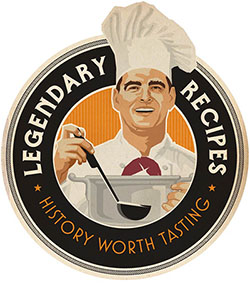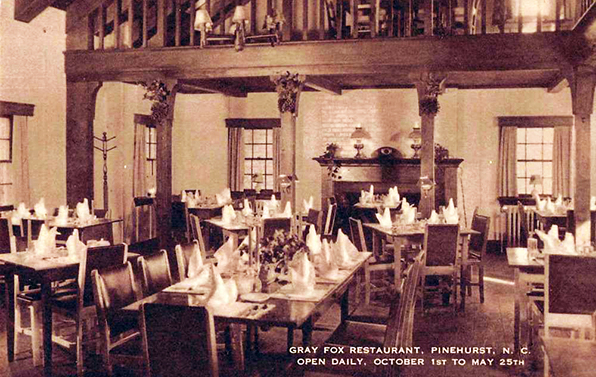In 1941 Charles Frederick Herman, carrying all his belongings in a single bag, arrived in Pinehurst, North Carolina, to take a job at the Gray Fox Restaurant, which had opened with considerable fanfare the previous year. Until recently Herman, an Austrian-born chef, had been in charge of the kitchen at Tony’s Trouville, a favorite café-society hangout on East 52nd Street in New York City. But now his mission was to replace the larger-than-life man who just the year before had created the Gray Fox: Bucharest-born Alexandru (Alex) Papană, who’d earned fame as a world-class bobsledder and member of the Romanian bobsled team in the 1932 and 1936 Winter Olympic Games, as a captain in the Romanian Royal Air Force, and as a daring pilot and stunt flier who in 1938 had been christened “The Rumanian Lindbergh” by newspapers all over the United States.
In the summer of 1940 Mr. and Mrs. Livingston Biddle II had been introduced to Papană in New York City, and they persuaded him to visit Pinehurst, where they spent every winter, to see if he might be interested in taking over the Village Court Grill, which they had opened two years earlier. Papană, having recently damaged his plane on the runway of the Chicago Municipal Airport, decided to take the Biddles up on their offer. His first step was to engage a French-Algerian chef who most recently had worked at the exclusive Yeamans Hall Club in Hanahan, South Carolina, just outside Charleston. Then he renamed the restaurant, installed one of his largest aviation trophies in a conspicuous spot, and placed ads in the local newspaper that said: “Lunch—Tea—Bridge—Dinner. French Chef, French Cuisine.”
Papană’s first season at the Gray Fox, however, would turn out to be his last. In 1942 he started playing in amateur tennis tournaments and then resumed his career as a stunt pilot, appearing in air shows across the country, often getting top billing. He also had his eye on Hollywood, and he would go on to have tiny and typically uncredited parts in at least eight major motion pictures, including Above Suspicion (1943), The Song of Bernadette (1943), and Passage to Marseilles (1944).
Meanwhile, with the United States having entered World War II, Pinehurst was booming in a big way. The city served as a support area for neighboring Fort Bragg, which was being transformed from a small artillery training post into one of the nation’s most important military installations. Construction workers poured into the region from all over the state, and at one point they were completing new buildings at Fort Bragg at a rate of one every 32 minutes. Many of them came into Pinehurst at night for dinner, drinks, and dancing, and the USO Club in the Pinehurst Theater was also a magnet for military personnel and their spouses or guests.
With Papană out of the picture, the Biddles settled on Herman to replace him, and he was soon as his way to Pinehurst to be the restaurant’s chef when it opened for the season in October 1941. (Papană’s life came to a tragic end in 1946 when, despondent over the state of his weeks-old marriage, he disappeared into the desert 16 miles south of Las Vegas, parking his car off the highway and walking some three miles to a ravine, where he ingested a lethal dose of poison. The sheriff’s office found his body a week, along with two suicide notes, one in his coupe and the other in his pocket, that lamented the couple’s “lost love,” saying, “We could have been so very happy.”)
The Biddles aimed to make the Gray Fox a first-class, fashionable French restaurant where they could entertain dozens of friends at a time. As chef, Herman obliged. The menu for his 1941 “Gala Christmas Dinner” featured (in this order): cream of mushroom soup or casaba melon; celery, radishes, and olives; roast turkey with cranberry sauce, candied sweet potatoes, creamed pearl onions, and fresh string beans; the “Gray Fox Salad Bowl”; hot rolls; for dessert, a choice of frozen cream puffs with chocolate sauce, mince pie, English fruitcake, or pumpkin pie; and coffee. This extravagant dinner was served from 1 p.m. to 9 p.m. for $1.75.
Patrons could dine either indoors or in an intimate courtyard, and Herman elevated the culinary stature of the Gray Fox to the point where the Raleigh News and Observer dubbed it “Pinehurst’s pièce de résistance to the gourmets of both the Army and civilian groups.” The restaurant was packed every night, inside and in the courtyard, with soldiers and their wives or dates. Harmon (Ham) Nelson, a musician who was best known as actress Bette Davis’s high-school sweetheart and first husband (they divorced in 1938), was stationed at Fort Bragg and became a regular at the Gray Fox, where after dinner he invariably ended up playing the piano for his own pleasure and that of the other patrons.
In 1945 Herman bought the Gray Fox from the Biddles, and at some point he also acquired a one-fourth interest in Village Court Company, Inc., which owned the building the restaurant occupied. Herman had once owned a restaurant in Chicago that went belly-up during the Great Depression, and he was determined not to let the Gray Fox fall victim to the same fate. Year by year the restaurant’s reputation grew. The only blip came in 1948, when state and county ABC agents put Pinehurst in their crosshairs, taking aim at “swanky night clubs and restaurants that are known to residents in all parts of the United States,” as the Raleigh News and Observer put it. “Officers said that some of the establishments sold drinks openly and in plentiful quantities,” the newspaper went on to report, and Herman, snared in a surprise nighttime raid, was one of more than 30 defendants charged with violating state liquor laws. (The enforcement drive soon petered out, even though the sale of liquor by the drink wouldn’t become legal in North Carolina until 1978.)
Herman, more than anyone else, made the Gray Fox into a Pinehurst institution—so much so that Marion Brown included several of his recipes in The Southern Cookbook, the wildly popular and still-in-print title that was originally published in 1951. Herman, however, didn’t confine himself to such high-end dishes as Lobster Newburg, which had been on his menus from the beginning. In 1959 the Gray Fox advertised “pizza pies to take out” in assorted sizes.
Herman died in October 1965 when he was pinned inside his wrecked car following an accident near the Moore County Airport. He was 77. He had no surviving relatives and left his $40,000 estate to charity, with most of it going to establish the Charles F. Herman Memorial Fund. His will stipulated that the fund was “to be used exclusively for educational purposes to assist needy and/or deserving persons of the Pinehurst School District in attending college or institutions of higher learning or schools or technical training.”
The Gray Fox closed with Herman’s death, but it reopened the following month with a new owner, Roy E. Babbin, who had acquired the restaurant from Herman’s estate and taken over its lease in the Village Court Building. Babbin, described in one newspaper account as “a professional opener of new food and beverage businesses,” specialized in flipping restaurants, which was evidently his plan for the Gray Fox. He restyled the restaurant as “The House of the Gray Fox” and the lounge inside as “The English Pub.”
But Babbin’s plan did go as expected, and in 1967 Livingston Biddle leased the Gray Fox to C.L. Worsham, Jr., Raymond Lee Williams, and Warwick Fay Neville. Worsham owned a supermarket and delicatessen in Pinehurst as well as a bakery and deli in nearby Southern Pines, and Williams, a butcher by trade, was the head of the supermarket’s meat department. (Neville, who’d begun his career as an investment banker with the Morgan Guaranty Trust Company in New York City, appears to have been a silent partner in the venture.)
But the restaurant business may have proved too much a challenge for Worsham and Williams. In 1970 they sold the Gray Fox to Wilma J. Cunningham, who had previously owned a restaurant in Akron, Ohio. The following year the Gray Fox changed hands yet again when Cunningham and her daughter sold it restaurant in 1971 to Thomas K. McNeil of New Jersey.
It was clear by now that the Gray Fox just wasn’t the same without Charlie Herman. Some said that most of the people visiting Pinehurst were choosing to eat meals at the hotels in which they were staying, but that explanation was only part of it. The churning after Herman’s death had clearly taken a big toll. In 1975 Bob Moore, the latest in the Gray Fox’s succession of owners, told a reporter that business at the restaurant was off about 40 percent over the previous years, saying, “It ain’t what it has been.”
The Gray Fox Restaurant closed its doors the following year. The space was then occupied by a gift shop, and when the gift shop closed it reopened once again as a restaurant. Later, Theo’s Taverna occupied the space for nearly 30 years before it closed in 2021.
Famous Patrons of Gray Fox Restaurant
- Dan Jenkins
- Jack Whitaker

Lobster à la Newburg
The Gray Fox Restaurant opened in Pinehurst, North Carolina, in 1940 and closed in 1976, More than anyone else, Charles Frederick Herman made the Gray Fox into a Pinehurst institution—so much so that Marion Brown included several of his recipes in The Southern Cookbook, the wildly popular and still-in-print title that was originally published in 1951. One of them was his version of Lobster Newburg, which had been on his Gray Fox's menu from the beginning.
Ingredients
- 1 pound (about 2 cups) cooked Maine lobster meat, flaked
- 3 tablespoons dry sherry
- 1/2 cup unsalted butter
- 1/4 cup all-purpose flour or instant flour
- 1 cup milk
- 1 cup heavy cream
- 2 egg yolks, beaten
- Kosher salt, to taste
- Cayenne pepper, to taste
Instructions
Soak the flaked lobster meat in the sherry for 1 hour.
In a large, heavy skillet over medium heat, melt the butter but do not allow it to brown. Whisk in the flour and blend until smooth, about 2 minutes. Gradually add the milk and cream, stirring constantly, until the sauce thickens.
Stir a small amount of the hot cream sauce into the beaten egg yolks. (This tempers the eggs so that they will not scramble.)
Whisk the now-tempered egg yolk mixture into the hot cream sauce. Continue cooking over medium heat, stirring constantly, for 1 to 2 minutes.
Add the flaked lobster meat, salt, and cayenne pepper and continue cooking over medium heat until lobster is heated through, but do not boil or sauce will scald.
Serve in a casserole or on toast points.
In Our Vault: More Recipes from Gray Fox Restaurant
- Breast of Guinea Hen with Bing Cherry Sauce
- Gray Fox Whole Wheat Bread
- Wild Rice










1 Comment
Bill Hogan
January 19, 2023 at 9:36 pmA tip of the toque to Susan Pockmire of the Moore County Historical Association in Southern Pines, North Carolina, who kindly offered her abundant and invaluable assistance as I researched the history the history of the Gray Fox Restaurant. I owe her a big debt of thanks for going above and beyond the call of duty. Any errors or omissions, though, are entirely my own. (If you see any, please let me know.)